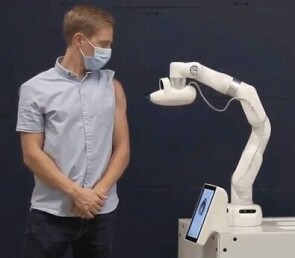A good friend of mine has 2 pathological fears: goats and robots. While having lunch with him recently, our conversation went like this:
Me: Now, I have to tell you something and I don’t want you to be upset.
Him: Okay.
Me: I can already tell you’re getting upset.
Him: No, I’m not.
Me: You know don’t you, you sense it.
Him: Just tell me.
Me: I bought one of those robot vacuums.
Him: (winces, silently shakes his head, looking at me like I’ve sold my soul to the devil)
Downsizing from a large house to a modest apartment this summer, it felt like overkill to continue employing a cleaning lady. But I did still want clean floors. Thus, this purchase that so deeply disturbed my friend.
My robot vacuum is a fascinating addition to my household. During the initial setup the iRobot app prompted me to name the device. I called him Sparktronic. From the start he (not it) became more than an appliance. Sparktronic is a mysterious entity. He offers vague clues to the future of work. My friend does not like this development.
Going about his business Sparktronic buzzes around deftly navigating corners, table legs, and power strips while sucking up my dirt and dander. On the app his exact location is displayed graphically. Data is recorded, patterns are mapped. He is like an RTLS tracking device for my Dorito crumbs.
The working sessions of my robot vacuum are not unlike having a pug in the house. He scampers around at ankle height, out of sight much of the time, bumping into things, making snuffling noises. Every once in a while Sparktronic goes suspiciously silent leaving me to wonder what mischief he is up to. Then just as I think I should investigate; he merrily resumes activities.
Unlike a pug, Sparktronic seems to be learning. In each successive session he cleans my place in less time, taking more efficient routes. The fine works and intellectual growth of my robot vacuum made me wonder what else was possible. I would investigate.
Robot vacuums are imbued with artificial intelligence, so says the iRobot app. You hear that term thrown around a lot these days along with others like machine learning and deep learning. Understanding these concepts seemed the key to reassuring my friend that I could live peaceably with a robot.
To spare you the journey down this techno-rabbit hole, here’s a brief summary of my studies:
Artificial intelligence is broad catchall phrase for technological systems that mimic the patterns of humans. Programmers have to tell computers exactly how to behave in order to do this.
Machine learning is a subset of artificial intelligence. Computers learn through extensive trial and error based on a few basic guidelines supplied by a human. My best guess is that this is what’s going on inside of Sparktronic’s cranium.
Deep learning is a subset of machine learning. It learns without the input of basic guidelines. Instead, it emulates the functions of human neural networks, much like the way children learn language.
For anyone interested in a more detailed explanation, this article is a great introduction:
How to explain deep learning in plain English
As futuristic as all this sounds, these forces are already around us. Common things we take for granted like chatbots, driving navigation, and online shopping recommendations are forms of artificial intelligence at work. Even more intriguing are advances in fields that were once thought to be the sole domain of humans. These include:
- Self-driving cars How driverless cars will change our world
- Project management Artificial Intelligence for Project Managers
- Vaccination shots A New Robot Delivers Vaccines Without Needles or Doctors
- Poetry Robot artist to perform AI generated poetry in response to Dante
- Medical research 230 Startups Using Artificial Intelligence in Drug Discovery
- Bartending Barney the Swiss robot bartender ready to shake up cocktails
These staggering innovations got my attention. Sure, artificial intelligence is poised to take some people’s jobs (sorry researchers and cleaning ladies). But what’s in it for me, the average lazy man-child?
With my deadline for this blog submission looming, I dared to seek the Holy Grail. I dared to ask: could artificial intelligence write a blog post for me? While Hemingway turned in his grave, I discovered that the answer was a resounding yes.
Jarvis is among the best of several tools in the artificial intelligence copywriting sphere. There is of course a cost, but I signed up for a free 5-day trial to discover it’s capabilities. Jarvis claims to have read 10% of the entire internet. It’s deep learning functions use that (somehow) as the basis to generate titles, introductory paragraphs, or entire blog posts. Inputting just a few keywords or ideas generates content in split seconds.
After some monkeying around with it, the thought occurred to me to test Jarvis’s self-awareness. I asked Jarvis to write a piece on the merits of deep learning. Here is the result:
Robots and Artificial Intelligence Developing Emotions: Personality in Non-Human Entities
Deep Learning is a powerful tool that can help solve many problems. In the future, it may be possible for Deep Learning to take on tasks like President of the United States. We’re not saying you should fear this technology; in fact, we think it’s an exciting prospect that could lead to better solutions than any human could provide alone. What are your thoughts? Let us know by commenting below!
Of my tests, this last output was the most plausible as human writing. But could it pass? Could artificial intelligence take my job as a blog writer? It’s not my cup of tea, but in a content-starved world maybe it’s viable. From a business standpoint, Jarvis does not need health insurance benefits. Just saying.
How does this all play out? My conclusion after all my research and trolling is this.
Sparktronic is a remarkable creature who has showed me a glimpse of the future. As much as I now depend on him, he’s no pug. Sparktronic’s machine learning brain has no interest in sitting on the couch with me watching “The Godfather” for the hundredth time. Barney the Cocktail-bot does not have a hot take on Sonny Corleone. Pugs and bartenders understand why these things matter to humans. It seems to me that artificial intelligence is a clear threat to the job security of some humans. But if you excel at what you do and you understand people, you’re probably safe. Probably.



I am not interested in a robot for President so Jarvis has some work to do on their algorithm.